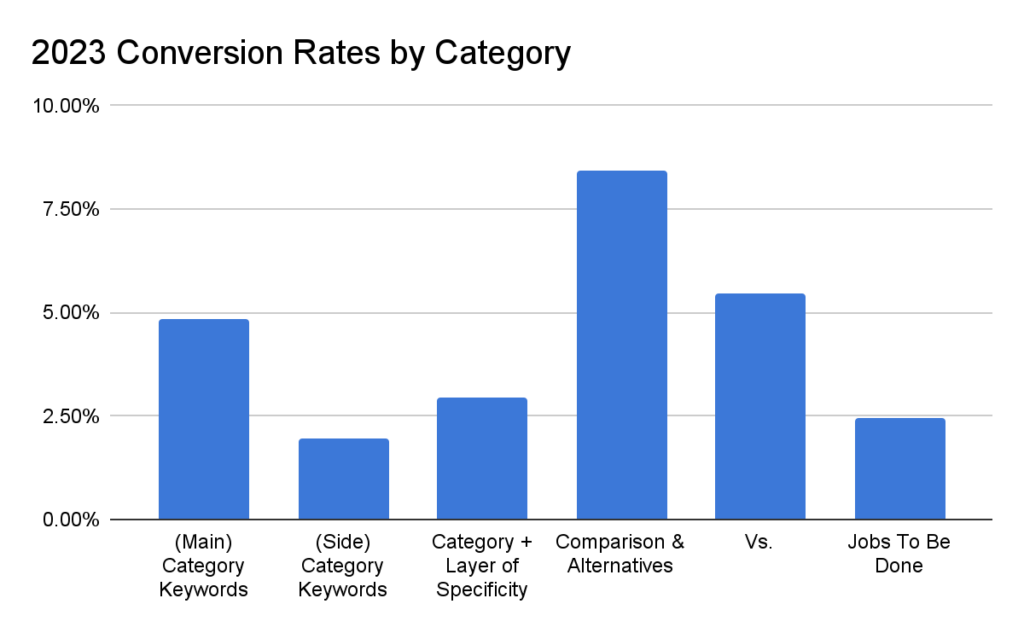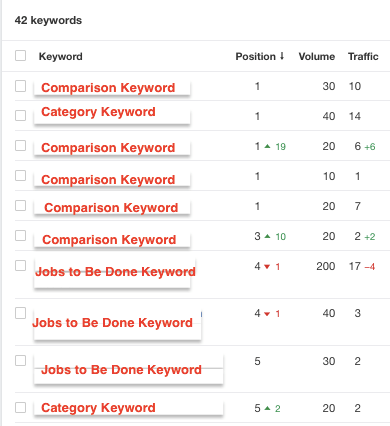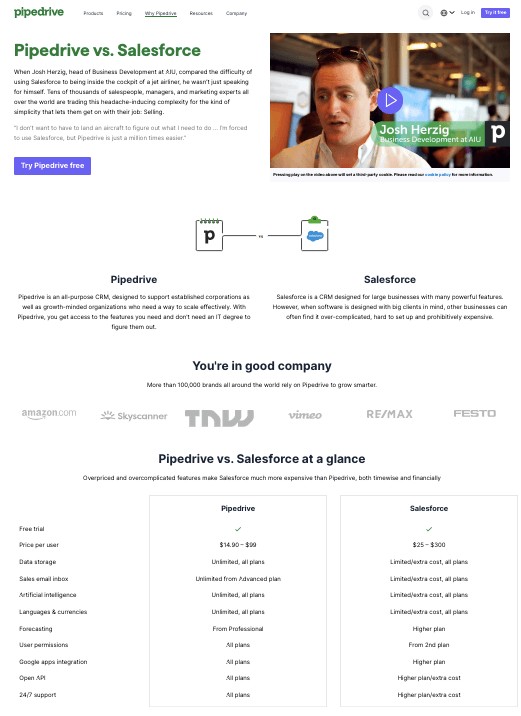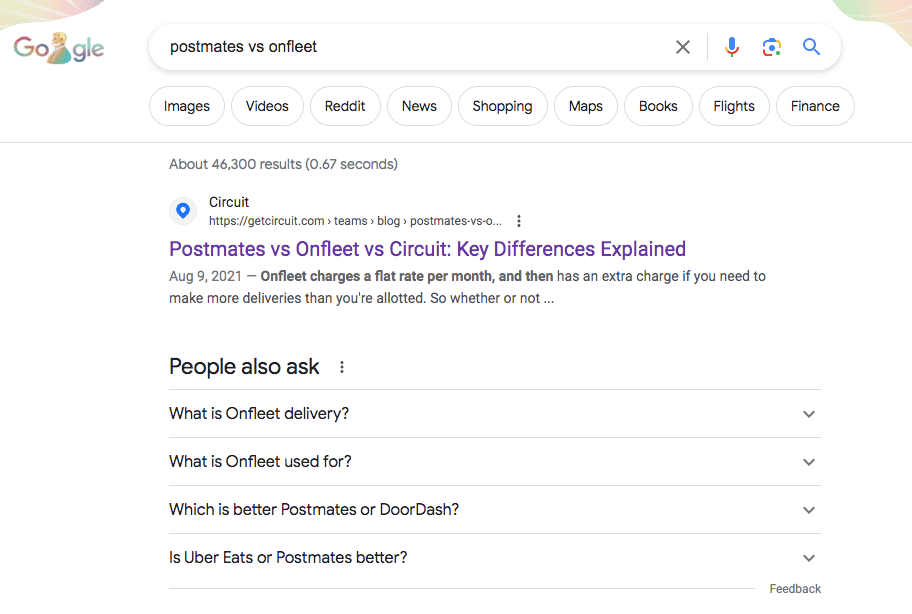Many companies are interested in either (a) how to create competitor comparison pages or (b) how to improve rankings or conversion rates from the ones they already have.
And for good reason. As we’ll show below, competitor comparison landing pages are some of the highest converting page types we have seen from the thousands of articles we’ve published for clients over the years.
So, in this post, we’re going to define what these pages are, discuss the main reasons why they’re worth creating for many businesses, and share three unique comparison page strategies that we’ve learned and used to drive significant conversions for our clients.
Below, we cover:
- What is a competitor comparison landing page?
- Why should you create competitor comparison landing pages?
- 3 unique strategies for creating competitor comparison landing pages
Note: If you’d like help creating pages to rank for your competitor comparison keywords, you can learn more about our agency here and reach out about working with us here.
What Is a Competitor Comparison Landing Page?
Competitor comparison landing pages are website pages in which you compare your product or service to a direct or peripheral competitor. Typically these pages include a feature comparison table, messaging about your service’s unique differentiators, social proof, and a call-to-action (CTA).
Originally, comparison pages were primarily used by SaaS businesses for PPC advertising, such as Google Ads. However, many SaaS companies (as well as eCommerce businesses) now incorporate comparison pages into their SEO strategies, creating them to rank for brand comparison keywords in organic search.
Why? Because if you can optimize your comparison pages to get organic search rankings for the same keywords you’d be bidding on through ads, you can generate conversions from that page over the long-term — without paying for every click.
Why Should You Create Competitor Comparison Landing Pages?
1. Competitor Comparison Pages Have Some of the Highest Conversion Rates of Any Type of Content
Competitor comparison keywords, including “versus” keywords (e.g. QuickBooks vs. FreshBooks) and “alternatives” keywords (e.g. QuickBooks alternatives), is one of the three bottom of the funnel keyword categories that we focus on in our client work.
In a recent analysis of 95 articles we’ve written for our clients — What SEO keywords convert the highest? — we found that comparison and alternative keywords had the highest average conversion rate of the posts that were measured.
Comparison and alternative keywords had a conversion rate over 7.5% and versus keywords had the second highest conversion rate at over 5%.
To our surprise, both of these comparison keyword categories converted higher, on average, than even main product category keywords (e.g. best accounting software), which are some of the most common-sense, must-have keywords in a bottom of funnel SEO strategy.

Furthermore, despite SEO tools often reporting these keywords as having a very low number of monthly searches, which might cause you to question whether these pages are worth creating, we have found that:
- These keywords almost always get more traffic than their monthly search volume estimates would suggest (often a lot more).
- With such high conversion rates, they can deliver significant conversion volume, even while generating less traffic than other pages.
For example, in our post on Mini-Volume Keywords, we show how 6 comparison articles (all with less than 20 searches per month) collectively drove 149 organic signups for a past client, with an average conversion rate of 2% and one post converting at 4.5%.
This is why competitor comparison pages are a high priority in our SEO content strategy, and, in our opinion, should be considered a valuable SEO asset for many businesses.
2. Competitor Comparison Keywords Can (at Times) Be Surprisingly Easy to Rank For
There are a number of accounts that we have worked on in which we’ve found comparison keywords to be some of the easiest and fastest keywords to rank for. We’ve seen this even in cases where a client’s domain rating was very low, and ranking for other buying-intent keywords was difficult and took a lot of time.
For example, we were working with a remote executive assistant service that had a domain rating of 28 (quite a low DR). And while many of the posts we produced for them were taking months to progress towards the first page of search results, the comparison keywords we targeted were getting onto the first page within weeks of publishing.
In looking in Ahrefs at their rankings today, we see that 5 out of 5 comparison keywords we went after are ranking in the top 3 positions of search results.

There are different factors that we think contributed to this. For one, we created in-depth dedicated pages targeting each of these keywords and optimized them very precisely in order to rank. But we also found that the competitors in their space hadn’t caught onto this strategy yet, leaving the door open for us to rank for these terms.
This obviously will not be the case for every business. Depending on your space, it may be more competitive and challenging to rank for these keywords. But anecdotally, we’ve had experiences where it was relatively easy to rank for comparison keywords with clients who were in competitive spaces as well as clients who were not.
Coupled with the high conversion rates discussed above, the potential for comparison keywords to be low hanging fruit from a rankings perspective is another reason they’re worth prioritizing.
3. Competitor Comparison Landing Pages Can Aid in the Sales Process
Lastly, the content and format of competitor comparison landing pages is well suited to inform potential customers about how a product or service differs from competitors’ products, and therefore can help prime prospects for sales conversations.
We’ve also had clients remark that they like the ability to direct prospects to comparison pages to help them better understand their unique selling propositions (USP) and the concrete differences between their products and relevant competitors that prospects may also be considering.
3 Unique Strategies for Creating Competitor Comparison Landing Pages
There are 3 unique comparison page strategies that we’ve found to work well but haven’t commonly seen discussed by other brands and agencies.
The first two strategies use long-form content to target comparison keywords instead of the usual short-form landing page format. The third strategy is to target different variations of competitor comparison keywords beyond just “brand vs. competitor.”
Let’s look at each.
1. Use Blog Posts Instead of the Usual Landing Page Format
The prevailing method for creating competitor comparison pages (as you have likely seen if you have ever looked at one) is to use a short-form landing page format.
In other words, a concise, conversion-focused page with the elements we discussed above: a feature comparison table, bullet points or short paragraphs about the service’s differentiators, customer testimonials, pricing comparison, and CTAs.
Here’s a SaaS comparison page example of Pipedrive vs. Salesforce that follows this usual format:

At first glance, there’s nothing overtly wrong with this page. But in our experience, there are a number of weaknesses with using this type of landing page format that blog posts or longer-form content can solve:
- These comparison landing pages are often too basic to be compelling to advanced prospects. We have looked at tons of comparison pages and too often they offer very little detail that is useful for helping (particularly advanced B2B SaaS) target audiences understand the true differences between competing products. This is especially true for prospects that have experience using products in your category, and are looking for an alternative that can solve their pain points better than their current solution.
- Landing page formats tend to be harder to get ranking. It’s often much more difficult to get a landing page to rank highly in search engines, especially for brands with lower domain ratings and authority in their space. A blog post format gives you more room to include relevant SEO keywords and answer the intent of the searcher, so blog posts often allow you to compete better with established competitors in the SERPs.
- Landing page formats are at times a mismatch for meeting search intent. There are cases in which top results for a comparison keyword are blog posts (not landing pages). This is Google signaling that searchers are looking for more in-depth content. In these scenarios, landing pages are unlikely to satisfy search intent and therefore unlikely to rank. And if a page doesn’t rank highly, it doesn’t matter how high its conversion rate is.
Furthermore, conversion rates of landing pages are not always higher than conversion rates of blog posts, as we discussed and presented data to support in a previous post. So using a blog post doesn’t necessarily mean you need to sacrifice conversion rate, and in some cases, blog posts can actually convert better than a landing page.
For all of these reasons, we typically use blog posts instead of landing pages when creating competitor comparisons, which can convert at an extremely high rate (as shown above) while solving all of these potential issues.
Check out our article on SEO content writing for an in-depth look at the writing process we use to create these pages.
2. Use a Hybrid Landing Page + Blog Post Format
We have also had success with using a hybrid comparison page format that adds long-form blog-style copywriting at the bottom of a comparison landing page to help with SEO ranking and provide greater detail for prospects that want it.
This can be approached in a number of ways. If you have pre-existing comparison landing pages and are having trouble getting them to rank, you can write longer form editorial content and add that to the bottom of those pages to help with SEO.
Alternatively, you could create the blog post first to have the highest likelihood of ranking. And then once you’ve achieved that ranking, build a landing page-style template around it later to optimize the page for conversions.
Lastly, you could create a hybrid page from the get-go. Either way, based on what we’re seeing, it’s absolutely worth testing a hybrid strategy.
You can find an example of us describing how we used this with a client in this post.
3. Target ‘Competitor vs. Competitor’ or ‘Competitor Alternatives’ Keywords to Get Discovered by Prospects Looking at Other Brands
A final strategy we use that’s less common is to look for “competitor vs. competitor” and “competitor alternatives” keywords. By targeting these variations, you can reach prospects that are showing clear buying-intent but may not have heard about your solution yet.
‘Competitor vs. Competitor’ Keywords
“Competitor vs. competitor” keywords are search queries in which prospects want to understand the differences between two of your competitors, not including you! This can be especially useful for startups or lesser known brands that have less search demand.
We’ll often use this approach when we search for our client’s brand versus competitor keywords in SEO tools and find there to be no registered search volume. For example, here’s a screenshot showing no registered search volume for “Circuit vs Onfleet” (Circuit being a past client of ours, Onfleet being one of their competitors).

Meanwhile, we found that there was some registered search volume for “Postmates vs. Onfleet” (both solutions in which Circuit could be a viable alternative), as shown here:

So, we created a three-way SaaS product comparison — “Postmates vs. Onfleet vs. Circuit” — to piggyback off of that search demand, and insert our client into that conversation and consideration among prospects.
At the time of this writing, that page ranks in position one for the query ‘postmates vs onfleet’ in Google:

There are a lot of instances in which these opportunities exist and are worth taking advantage of, especially for small businesses with lesser known brands.
‘Competitor Alternatives’ Keywords
While most people associate competitor comparison landing pages with only “versus” keywords, “competitor alternatives” keywords are a close cousin that many marketers ignore but that actually convert the highest out of all the buying-intent keyword categories we’ve measured.
People often search these terms when they’re either (a) a competitor’s customer that’s unsatisfied with their current solution, or (b) wanting to compare the solution they’re considering to other options before making a purchase decision. In both cases, their buying-intent is high and these are valuable prospects to show up for in search results.
So, in addition to targeting “brand vs. competitor” and “competitor vs. competitor” keywords for our clients, we also look for opportunities where there is some search demand for their “competitor alternatives” keywords.
As a hypothetical example, if we were working with Podia, a platform for building websites and digital products (online courses, webinars, etc.), and their sales team said that their top SaaS competitors were Wix, Squarespace, ClickFunnels, and WordPress — we’d plug “wix alternatives,” “squarespace alternatives,” etc. into our SEO tools, assess search volumes, analyze the search results for each term, and prioritize which ones to go after.
We’ll typically target these pieces with list-style blog posts because that is what search intent generally calls for. We put our client at the top of the list and walk through their unique differentiators in detail to clearly communicate the advantages they can offer over other solutions. Then, we include a call-to-action to reach out and learn more about their service before carrying on with the list of competitors.
Learn More about Our SEO and Content Marketing Agency
- Our Agency: If you want to hire us to execute a content marketing strategy built around driving lead generation and sales, not just traffic, you can learn more about our service and pricing here. We also offer a paid search service, which you can learn about here.
- Join Our Content Marketing Team: If you’re a content marketer or writer and would love to do content marketing in this way, we’d love to have you apply to join our team.
- Our Content Marketing Course: Individuals looking to learn our agency’s content strategy and become better marketers, consultants, or business owners can join our private course and community, taught via case studies, and presented in both written and video content formats. We include several details and examples not found on this blog. Our course is also built into a community, so people ask questions, start discussions, and share their work in the lesson pages themselves, and we, along with other members, give feedback. Learn more here.








